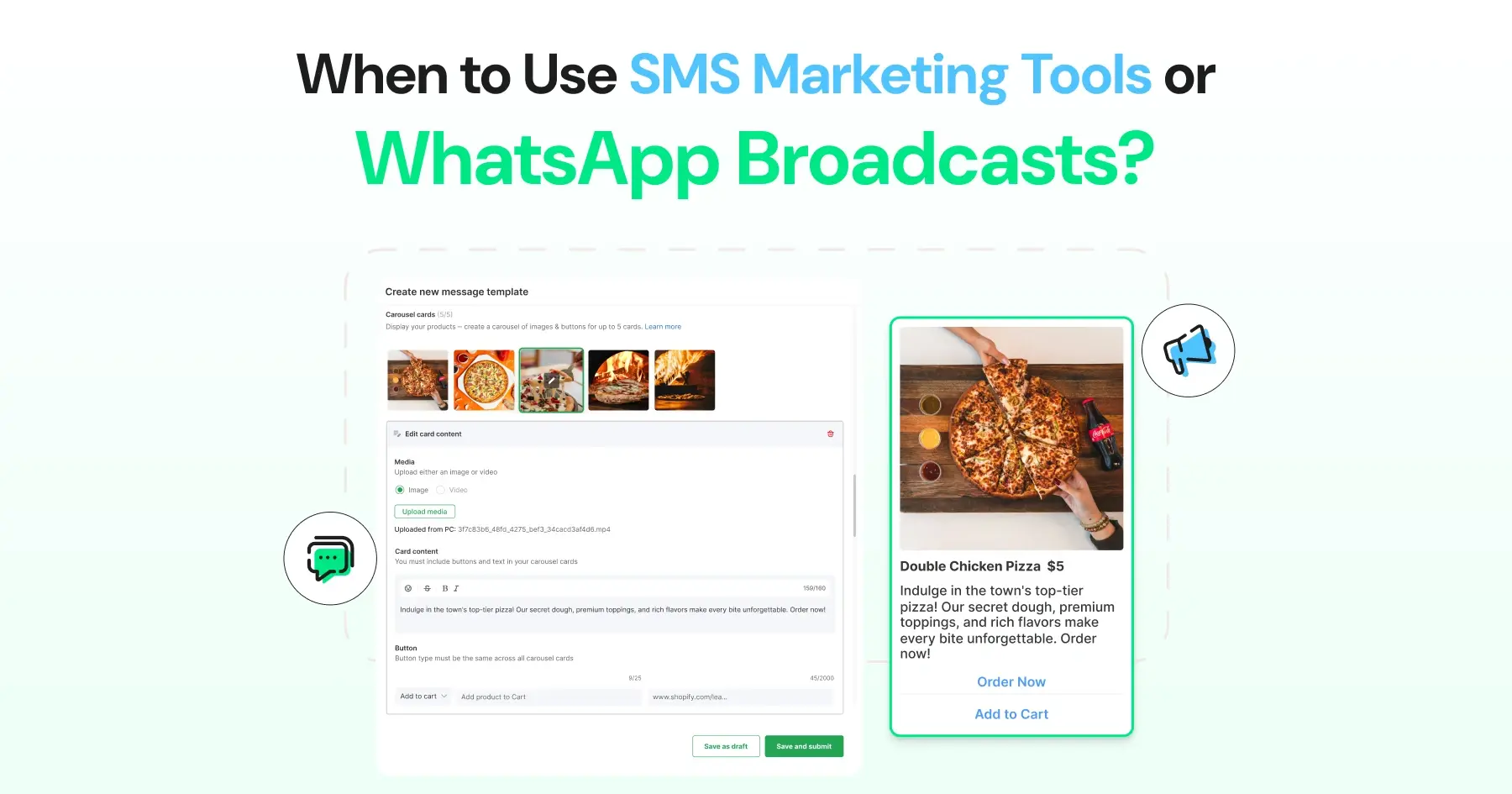
SMS Marketing Tools vs WhatsApp Broadcasts: When to Use Each for Maximum Impact?
Written by:
 Ashwin
|
on:
October 27, 2025
|
Fact Checked by :
Ashwin
|
on:
October 27, 2025
|
Fact Checked by :
 Namitha
|
According to: Editorial Policies
Namitha
|
According to: Editorial Policies
Too Long? Read This First
- WhatsApp Broadcasts are ideal for engagement, personalization, and interactive messaging.
- SMS Marketing Tools provide reliable delivery for urgent alerts and restricted regions.
- WhatsApp broadcasts require Meta-approved templates, while SMS is text-only and less personal.
- The best strategy is to combine both with Wati’s WhatsApp Broadcast and SMS Marketing feature for complete coverage.
Businesses today can’t rely on just one channel to reach customers. While WhatsApp has become a favourite for conversational marketing, SMS marketing tools remain one of the most reliable ways to guarantee delivery and extend reach.
The real question is when to use WhatsApp broadcasts and when to rely on SMS marketing tools.
In this blog, we’ll explore the strengths of each channel, the scenarios where they shine, and how combining them can give your campaigns maximum impact.
Why aren’t Your Messages Reaching Customers?
For most businesses, the challenge is not creating campaigns but ensuring those campaigns and influence the right people. Every business would’ve come across these problems:
Geography as a Barrier
A perfectly designed WhatsApp broadcast fails in a particular country because marketing templates are restricted, leaving customers uninformed
When Timing Kills Urgency
A time-sensitive promo goes unread because the customer is offline, and by the time they see it, the opportunity to act has already gone. What could have prompted quick action now loses its impact.
Pipeline Friction
Sales teams often watch deals stall because follow-ups are delayed or messages are never delivered. A lead that could have been converted slips through simply due to a communication breakdown.
Operational Inefficiency
Running WhatsApp and SMS campaigns separately means switching between platforms, exporting lists, and reconciling reports. This slows execution and creates blind spots in performance tracking.
Compliance Headaches
Messaging rules differ across regions, and ignoring them can lead to blocked campaigns or even account suspension.
On WhatsApp:
- United States: Marketing messages to +1 numbers are restricted; only utility updates like OTPs and order confirmations are allowed.
- European Union: GDPR requires clear consent and easy opt-outs.
- Global: Promotional templates need prior Meta approval and user opt-ins.
On SMS:
- United States: TCPA mandates written consent and opt-out options.
- Canada: Regulators enforce strict consent and unsubscribe requirements for promotional texts.
Without a platform that adapts to regional policies automatically, compliance becomes an everyday obstacle, limiting reach, delaying campaigns, and risking trust.
WhatsApp Policies to Consider
- Template approvals: Every outbound promotional message requires Meta’s approval. Overly promotional or non-compliant templates can be rejected.
- Messaging limits: Businesses start with lower daily messaging limits, which increase as the message quality score improves.
SMS Regulations to Consider
- Pre-registration requirements: In countries such as India, businesses must register their SMS templates before sending campaigns.
- Cross-border costs: International SMS is subject to higher charges and stricter routing rules compared to domestic campaigns.
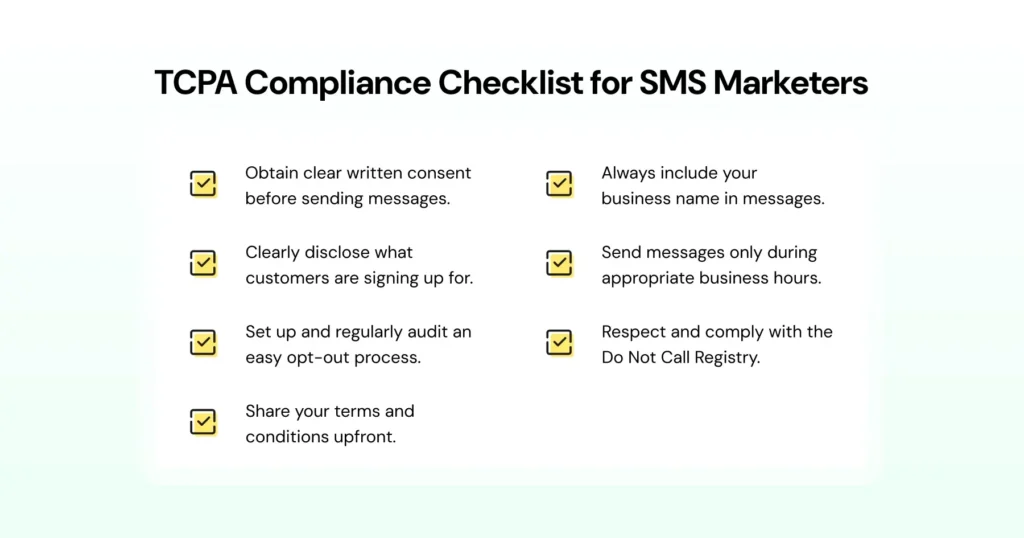
Businesses that align with these rules build credibility while protecting message deliverability and brand trust.
What Makes WhatsApp Broadcasts Effective?
For many businesses, communication is not just about reaching their customers’ inboxes. It is about creating timely, relevant, and personal interactions that influence decision-makers and nurture trust.
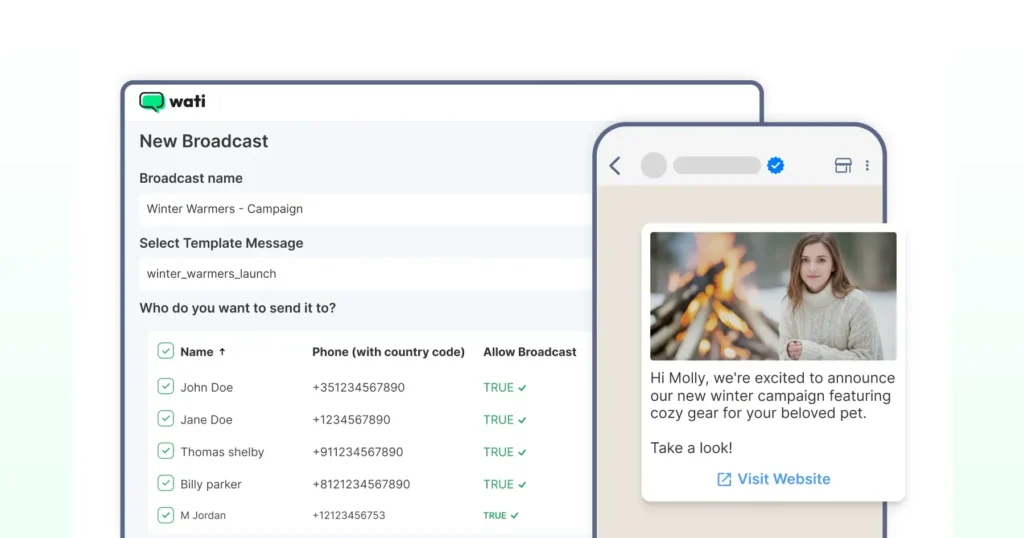
WhatsApp broadcasts are effective because they enable you to send messages to many recipients, while each person experiences it as a private 1:1 conversation. This format avoids the “bulk message” stigma of group chats.
High Open Rates
WhatsApp messages are typically read within minutes. For businesses, this makes broadcasts a reliable feature to share urgent updates, webinar reminders, or product announcements that cannot sit unread in an email inbox.
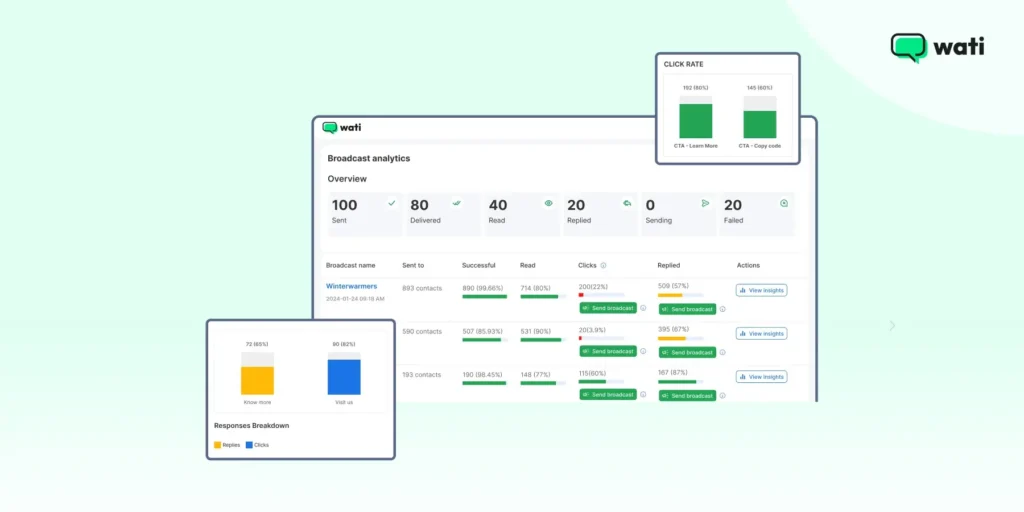
Rich Formats
Unlike SMS, WhatsApp broadcasts support media-rich templates.
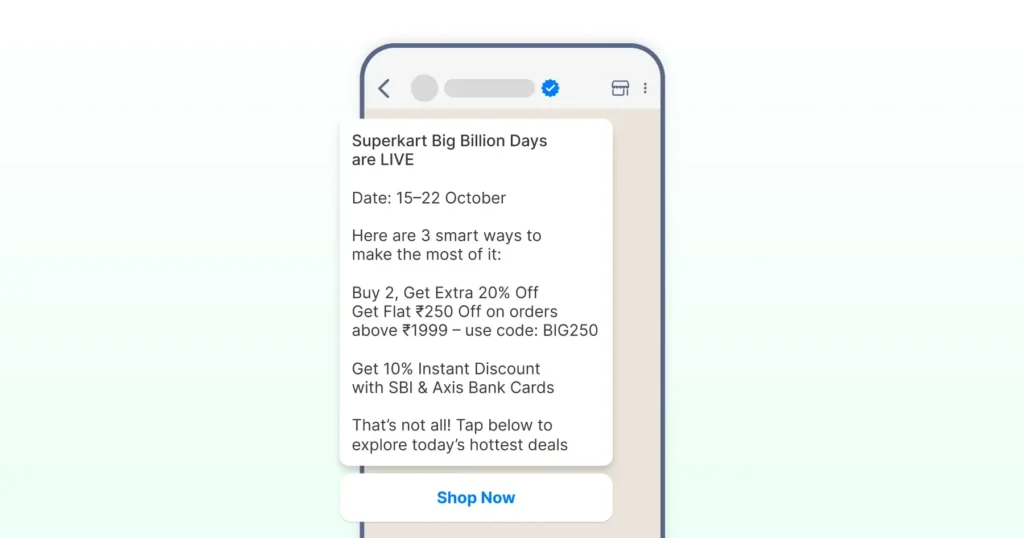
Businesses can share brochures as PDFs, product demos as short videos, price sheets as images, or even use interactive buttons to direct prospects to a booking page or case study.
Two-Way Engagement
WhatsApp is inherently conversational. A prospect who receives a broadcast about a new solution can instantly reply with questions, allowing your sales or customer success teams to pick up the conversation without delay from their team inbox.
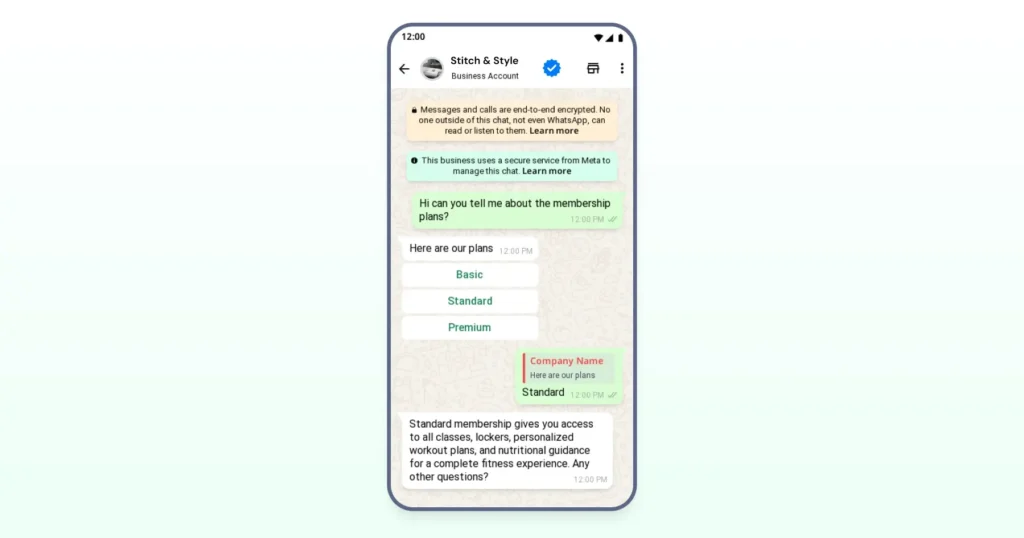
This eliminates the friction of moving out to another platform.
The Limitation
WhatsApp broadcasts come with certain restrictions since the platform falls under Meta’s business messaging policy:
- Businesses cannot freely send any message; every template must go through Meta’s review process before it’s sent out. To make this easier, Wati offers a ready-to-use Template Library with templates that speed up approvals and reduce the risk of rejection.
- Overly promotional, misleading, or policy-violating content may be rejected. Repeated violations can also hurt your WhatsApp Broadcast Quality Score, which in turn can lower messaging limits or even trigger account restrictions.
This makes WhatsApp marketing a better option when your goal is guaranteed delivery across regions.
Does SMS Marketing Still Work in 2025?
SMS may have been around for decades, but its strength lies in its simplicity and reliability. While it does not offer the same interactive features as WhatsApp, it remains one of the most direct and dependable ways to reach customers instantly, especially when internet access or platform restrictions limit other channels.
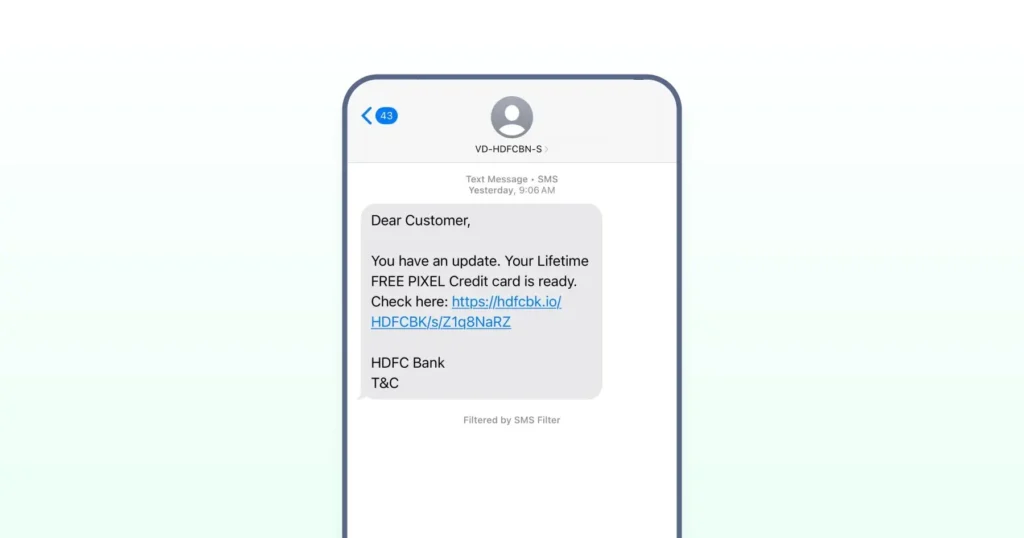
For example, a global e-commerce brand running a sale might find its WhatsApp marketing templates blocked in the United States due to Meta’s restrictions. In such cases, an automated SMS campaign ensures customers still receive the offer on time, preserving both reach and revenue opportunities.
Unlike newer platforms that depend on internet access, SMS works everywhere with just a mobile number. It is widely trusted and remains a core part of a multi-channel communication strategy.
SMS is particularly valuable for businesses because it cuts through complexity and ensures that important information always reaches its destination.
Why Should Businesses Pay Attention to SMS Marketing?
- Global reach: Works in every region, including countries where WhatsApp broadcasts are restricted or not permitted for marketing.
- No internet access needed: SMS only requires a mobile network, making it ideal for audiences with limited connectivity or in regions with poor internet coverage.
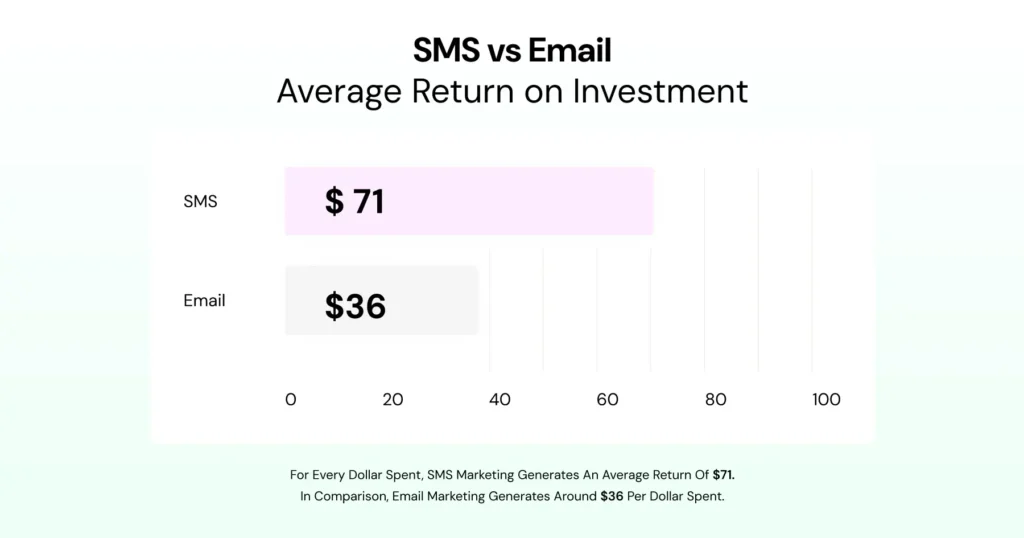
- Reliable delivery: SMS is highly effective for time-sensitive notifications such as system alerts, scheduled maintenance updates, or reminders. In fact, the average response rate for SMS campaigns is around 45%, which is far higher than most email campaigns.
- High visibility: SMS inboxes are far less cluttered than email, which improves the likelihood that critical updates will be read.
Best Suited For
- Running flash sales, discount codes, and urgent promotions: Especially effective when campaigns are time-bound and require immediate visibility.
- Sending critical alerts such as payment reminders, delivery delays, or OTPs: Some use cases are finance companies confirming transactions or internet service providers sending downtime alerts.
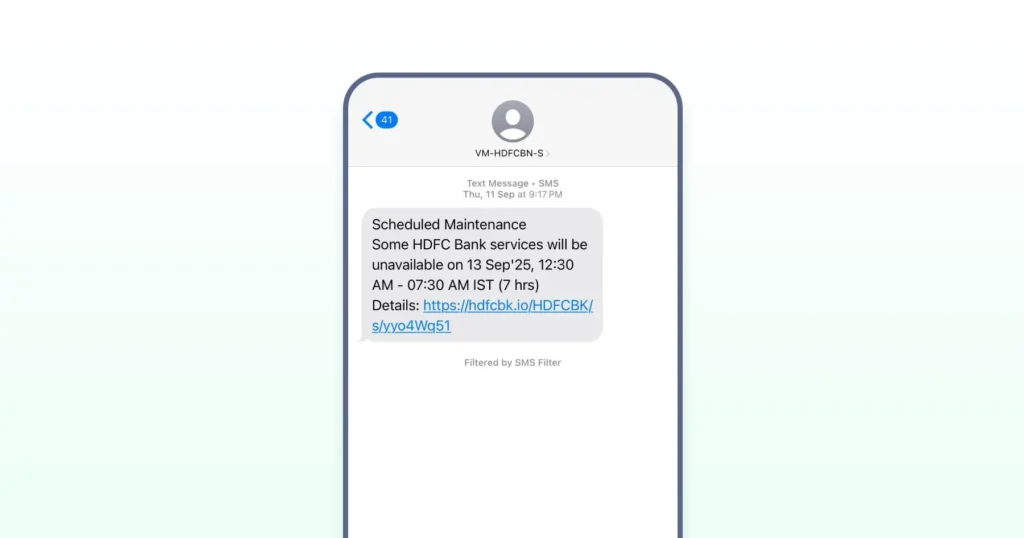
- Reaching audiences in WhatsApp restricted regions or in markets where SMS remains dominant: For example, some countries restrict WhatsApp marketing, making SMS the default alternative.
- Broadcasting simple, short updates to large segments: Reaching out to your audience becomes much easier when powered by SMS marketing tools that support scheduling, analytics, and automation.
The Limitation
SMS has certain constraints. It is limited to text only, lacks interactive elements, and may feel less personal than WhatsApp. Message length is restricted, and it cannot support rich media such as PDFs and images.
While SMS is reliable, it is not designed for long-term conversational engagement. For this reason, SMS is best used to complement other channels rather than as a standalone strategy.
When Should You Use SMS or WhatsApp?
| Scenario | WhatsApp Broadcast | SMS Marketing |
| Personal engagement with customers | Yes | Limited |
| Sharing media-rich campaigns (images and PDFs) | Yes | No |
| Time-sensitive alerts & OTPs | Possible, but not always reliable | Ideal |
| Regions where WhatsApp marketing is restricted | Limited | Reliable |
| Building brand relationships | Strong | Weak |
| Mass outreach where reliability matters | Risk of restrictions | Best choice |
If you are evaluating WhatsApp and SMS as broader marketing channels, you might find our detailed guide on WhatsApp Marketing vs SMS Marketing helpful.
Where Wati Fits in: Bringing WhatsApp and SMS Together
This is where Wati’s new SMS Marketing feature becomes a game-changer for businesses. Instead of choosing between WhatsApp and SMS, you can now bring both channels together in one unified platform.

This eliminates the inefficiency of managing multiple tools and ensures that your campaigns always reach the intended audience.
With Wati, your team can design, launch, and monitor both WhatsApp and SMS campaigns side by side. This dual approach provides flexibility across regions and compliance environments, giving you complete confidence in your campaign outreach activity.
Two Ways Wati Helps You Go Beyond WhatsApp
1. Automated SMS Fallback
If a WhatsApp broadcast cannot be delivered due to policy restrictions, template rejections, or delivery failures, Wati automatically triggers the same message via SMS. This ensures:
- No customer is left out of the conversation, regardless of region or platform rules.
- Smart channel switching with real-time delivery tracking and confirmation ensures that your team knows exactly which messages were delivered by which channel.
- Stronger campaign performance with reliable dual channel coverage that reduces missed opportunities and protects ROI.
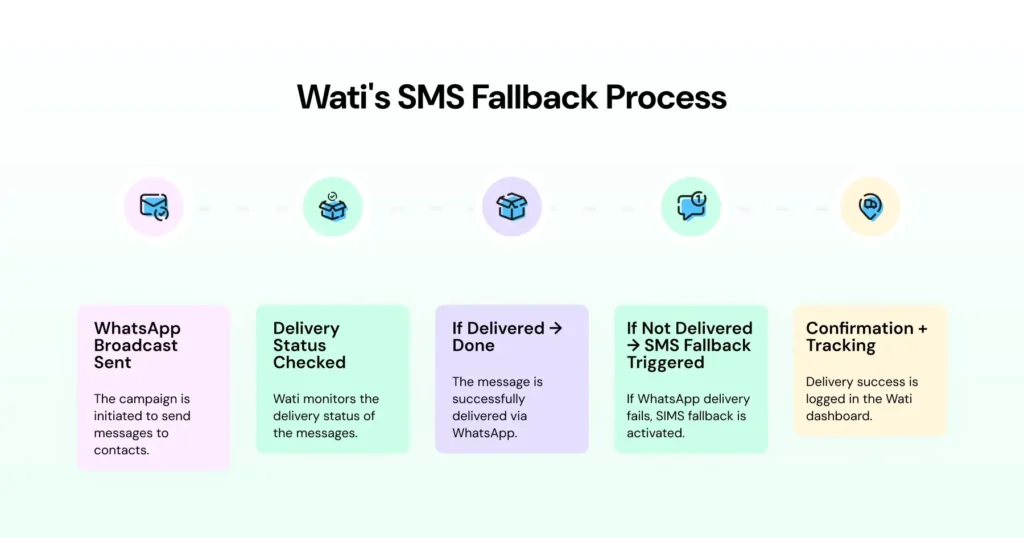
Think of it as a built-in safety net for your campaigns. Even when WhatsApp encounters roadblocks, the fallback system ensures your message still gets delivered to your audience.
2. Direct SMS Broadcast Campaigns
You can also launch SMS broadcasts directly from the same dashboard where WhatsApp campaigns are managed. This gives you:

- Global coverage across regions where WhatsApp marketing is restricted or regulated.
- Instant delivery for alerts, promotions, and time-sensitive messages such as compliance notifications, flash sales, or service downtime alerts.
- Unified management of multi-channel outreach so your marketing team no longer needs to juggle separate platforms for WhatsApp and SMS.
When to Use Each with Wati?
- WhatsApp Broadcasts: Ideal for engagement, personalization, and interactive formats such as catalogs or buttons.
- SMS Broadcasts: Recommended when reach, reliability, and compliance are the priority, particularly for time-critical updates.
- Both Together: Most effective when you want complete coverage across regions and customer segments, ensuring every recipient receives your message through at least one channel.
How Multi-Channel Campaigns Deliver Measurable Results?
Bringing WhatsApp Broadcasts and SMS Marketing Tools together is not just about convenience. It changes how businesses measure, optimize, and prove the value of their customer communication. The outcomes are tangible and measurable:
Stronger Brand Visibility Across Markets
- Brands can design one strategy and let the system route intelligently: WhatsApp first, SMS fallback when required.
- This unified approach eliminates blind spots in customer outreach, giving confidence that every campaign has truly reached its intended audience.
Higher ROI and Measurable Impact
- Traditional WhatsApp-only campaigns risk template rejection or region-specific bans, which lower campaign ROI. With SMS fallback, those gaps are filled instantly.
- Marketers can track delivery rates, response rates, and channel-level attribution to see where ROI is being generated.
Better Customer Retention and Experience
- Customers expect timely, relevant, and reliable communication. A missed message can mean a missed renewal or a lost upsell opportunity.
- WhatsApp broadcasts keep the experience rich and interactive, while SMS ensures the critical fallback for time-sensitive alerts such as OTPs, billing reminders, or downtime notifications.
- This dual-channel strategy builds trust by showing customers that your business is always reachable and responsive, no matter the platform or connectivity
Simplifying How Teams Run Campaigns
- Without integration, marketing teams juggle between multiple platforms. This creates inefficiency and reporting gaps.
- A unified WhatsApp + SMS dashboard allows campaign creation, automation, and performance tracking in one place.
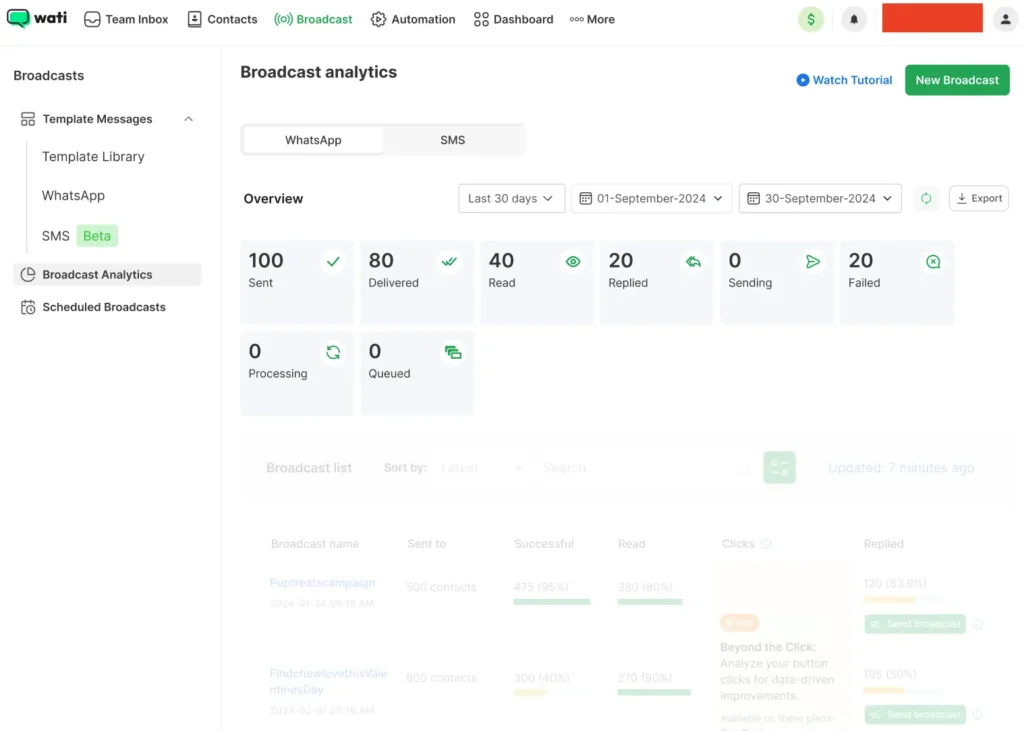
- APIs and CRM integrations mean campaigns can be triggered automatically based on customer actions (e.g., failed payment > WhatsApp reminder > SMS fallback).
- The outcome is fewer repetitive tasks, faster campaign rollouts, and more bandwidth for teams to focus on strategy, personalization, and scaling.
Measuring ROI Across WhatsApp and SMS
Just knowing how many messages were sent isn’t going to help. What you’d need is evidence of pipeline impact, lead quality, and retention outcomes. That is where analytics and attribution come in.
What to Measure?
Delivery Rate: SMS usually delivers everywhere, while WhatsApp may face restrictions in some regions. Tracking both gives you the real picture of your campaign’s reach.
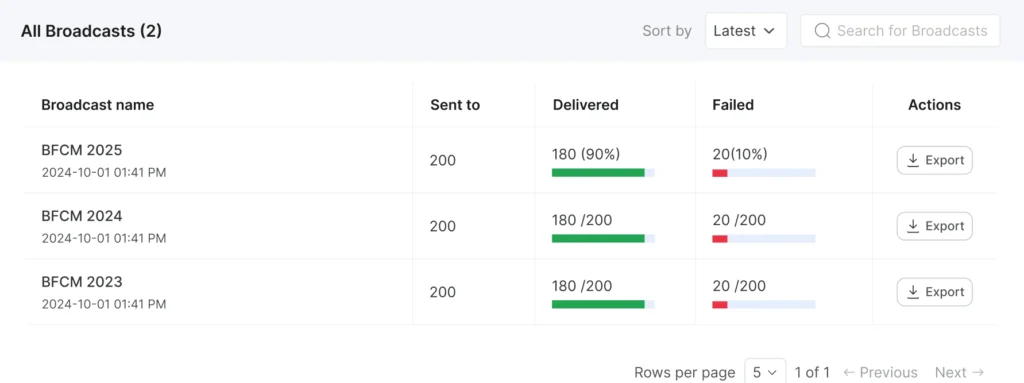
- Read Receipts: WhatsApp provides read confirmation, letting you measure visibility.
- Click-Through Rate (CTR): Crucial for a B2B company where a click means a demo booked, a document downloaded, or a pricing page visited.
- Response Rate: Unlike SMS, WhatsApp supports two-way replies. Tracking responses helps measure conversational engagement and lead qualification speed.
Why it Matters in B2B?
- Sales acceleration: Sales leaders care whether faster replies lead to shorter deal cycles.
- Marketing ROI: CMOs want to know which channel drives a lower cost per lead or opportunity.
- Compliance: Operations want proof that fallback mechanisms prevent drop-offs in restricted markets.
Industry Playbook: WhatsApp vs SMS in Action
SaaS & Technology
Problem: Product updates get ignored in cluttered email inboxes. Renewal reminders often go unnoticed.
Solution: Use WhatsApp Broadcasts to announce new features with media (demo video, release notes). If delivery fails, SMS fallback pushes renewal reminders or trial expiry alerts instantly.
Outcome: Higher renewal rates, faster adoption of features, and lower churn.
Retail & E-Commerce
Problem: Cart abandonment and time-bound offers need immediate visibility.
Solution: Send interactive WhatsApp messages with product images and buy-now buttons. For urgent deals or abandoned cart nudges, trigger SMS if WhatsApp is undelivered.

Outcome: Increased conversions during flash sales, reduced cart abandonment, and stronger customer retention.
Financial Services
Problem: Compliance-heavy information like KYC updates, payment reminders, or fraud alerts must be timely and guaranteed. WhatsApp restrictions in some regions limit outreach.
Solution: Send policy updates via WhatsApp, but ensure OTPs, fraud alerts, or payment confirmations fall back on SMS for reliability.

Outcome: Reduced risk, improved compliance, and stronger customer trust in high-stakes communication.
Quick Checklist Before Launching Your Campaign
- Is this campaign about engagement or guaranteed delivery?
- Does your audience sit in WhatsApp-restricted regions?
- Will the message lose impact if delayed?
- Do you need rich media, or is text enough?
- Can one missed delivery equal a lost sale or compliance risk?
If your priority is engagement, choose WhatsApp.
If your priority is reliability, choose SMS.
If you need both, use Wati to bring them together.
The Takeaway
The best marketing strategies involve knowing when to use WhatsApp or SMS, not choosing between them.
WhatsApp broadcasts build relationships. SMS marketing guarantees reach. Together, they give businesses an edge in delivering impactful, reliable communication.
With Wati’s new SMS Marketing feature, you don’t have to pick one channel over the other. You can do both from one platform.
Ready to explore smarter outreach? Try Wati today and experience the best of WhatsApp + SMS.
FAQs
Is SMS marketing still effective in 2025?
Yes, SMS marketing is still highly effective. It works globally, does not require internet access, and is one of the most reliable channels for urgent promotions, alerts, and OTPs. Open rates for SMS remain consistently high across industries.
What is the difference between WhatsApp broadcasts and SMS marketing?
WhatsApp broadcasts allow businesses to send rich, interactive messages like catalogs, images, and buttons, making them ideal for engagement. SMS marketing, on the other hand, focuses on reliability and reach, especially in regions where WhatsApp broadcasts face restrictions.
When should I use WhatsApp broadcasts instead of SMS?
Use WhatsApp broadcasts when you want personalization, interactive formats, and two-way engagement. For example, product launches, promotions with media, or relationship building.
When should I use SMS marketing instead of WhatsApp?
Use SMS marketing for urgent updates, time-sensitive alerts, or when targeting regions where WhatsApp broadcasts are restricted. SMS is also better for reaching customers without internet access.
Can WhatsApp and SMS be used together in one campaign?
Yes. With Wati’s SMS Marketing feature, you can combine both. If a WhatsApp broadcast fails, an SMS fallback ensures delivery. You can also run SMS broadcast campaigns alongside WhatsApp, all from one platform.
Do I need separate tools to run SMS and WhatsApp campaigns?
Not if you use Wati. Traditionally, businesses used separate platforms for SMS and WhatsApp. Wati simplifies this by offering both WhatsApp broadcasts and SMS campaigns in one unified dashboard.



Latest Comments